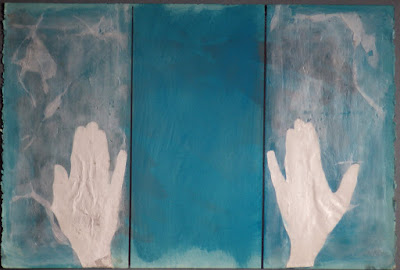This piece, also from 1983 I think, is collage and wax paper on board. The image of the hand, as a metonym for a person, is relevant to the embossed prints I am doing now for my book "Ghost".
So when I read about an introduction to encaustic painting workshop being facilitated by Joanna Kidney at Outpost Studios here in Bray I jumped at the chance to attend. Lucky for me I secured the last place on the intimate workshop, and had a nice stroll across the park last Sunday morning to Outpost Studios. After an introduction to the technique, Joanna offered the participants a choice of wooden blocks to use as mounts for our workpieces that would allow us to learn a variety of techniques.
As a starter, I chose a fairly small piece of wood and thinking of The Skipping Project, used the form of two jumping feet with which to experiment. After a quick sanding of the sides, we applied a clear layer of beeswax mix, and then two layers of whitened beeswax mix. After any layer of beeswax (coloured or clear), the block must be heated to fuse the wax to the layer below. For the first block we used a variety of tools to scrape, incise, carve, etc. the block in between applying colours (in heated wax). There was also a good supply of fat oilsticks, oil pastels, and a hot wax drawing tool to use in conjunction with the pre-mixed paints (with various sizes of brushes) warming on the hot surface of a flat type of "griddle". Joanna pointed out that an important tool to have is a specialty flat thermometer on the griddle to ensure that the wax paint does not overheat and fume, as this can be quite toxic.
In the afternoon, with another block, we learned about collage techniques for embedding objects and images (in my piece below there is a pictue of two rocks, wool, thread, and cous cous). We also learned how to transfer an image from a photocopy or print out directly onto the wax; in my case below I transferred the image of some pebbles from a colour photocopy of a photograph I took, as reference for the Stones book of prints that I am making.
In the afternoon of the workshop, Joanna also gave a demonstration of monoprinting in encaustic. A space was cleared on the griddle and one could brush on paint or draw with oil pastels or oil sticks (the drawing/painting melting on the warm griddle) and there were a variety of papers to choose from to experiment with how the different grounds interacted with the wax, also depending on which wax medium was used!
This is Fabriano paper as a ground for a mix of brush work and oil pastel drawing.
Again, a mix of brushwork and oil pastel for my "Dreamboat" image, but pulling the card away from the griddle leaves a pattern.
I only added a bit more wax colour to this rice paper Dreamboat.
I was thinking of Fort Carré when I brushed out this simple image of light and dark on Fabriano paper. The turquoise was drawn with oil pastel.
What a fabulous day for creative play with an interesting medium and a wonderful facilitator!









































